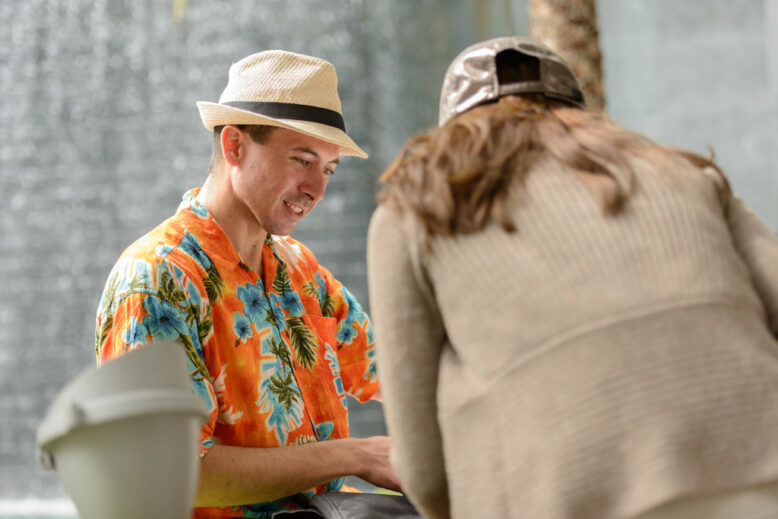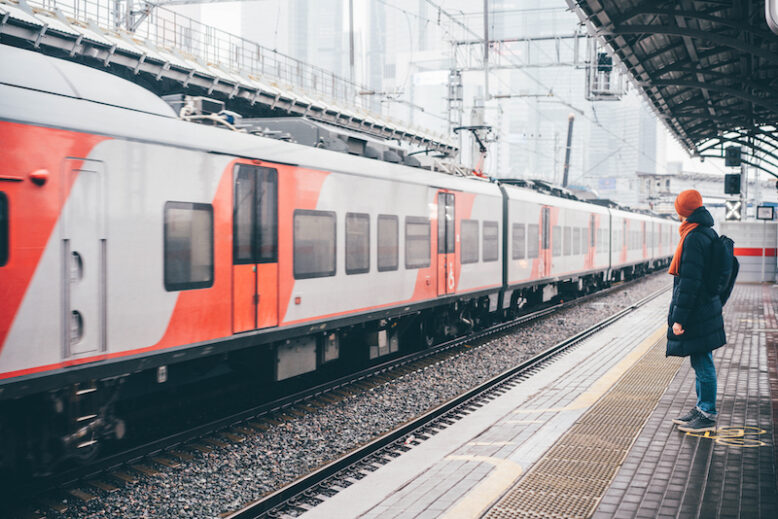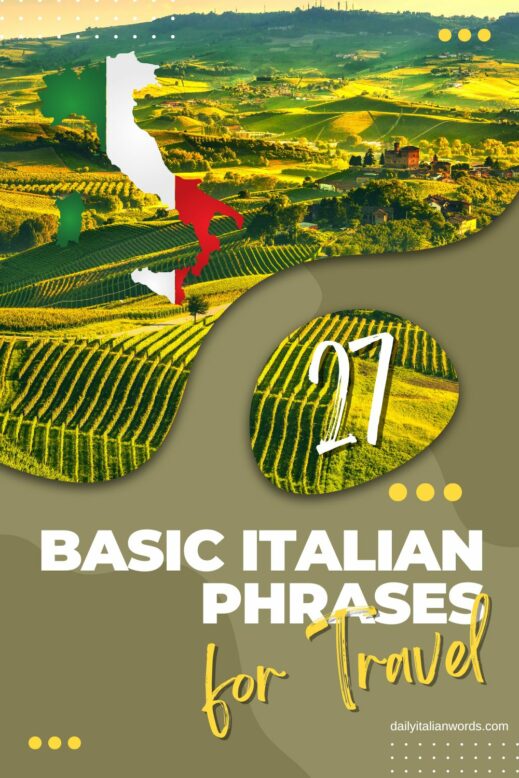Contrary to popular belief, the best way to learn Italian for travel isn’t to memorise an entire travel phrase book from start to finish, but rather, to pick out a few key phrases that will come in handy over the course of your stay in Italy … and that you will actually remember!
After all, there’s no point in learning complex sentences like “Il terminal A è per i voli internazionali” (Terminal A is for international flights) or very specific terms like “il doganiere” (customs officer) if you only ever use them once!
In this article, we’ve selected what we think are the twenty seven key Italian phrases tourists should learn before visiting Italy, simply because they are guaranteed to crop up over and over again. If you make the effort to memorise these common phrases, not only will you be able to communicate more effectively with Italians about your basic needs, but you will also show respect for the culture and language of Italy.

Buongiorno.
Buonasera.
Ciao.
Arrivederci.
If you’re going to start anywhere, let it be with the most basic Italian greetings. Even if you forget everything else in this article, you can be sure that a friendly “Hello!” will go a long way towards making the Italians around you feel more comfortable and appreciated.
The most polite greetings you can use are:
Buonasera.
Good evening. / Hello. (formal)
These greetings should be used with people you don’t know, such as shopkeepers, waiters, or anyone else who provides you with a service. Although they translate as “Good morning” and “Good evening” respectively, they are often used in situations in which we would naturally say “Hello” in English.
When saying goodbye, the safest option is the expression arrivederci, especially in formal settings.
Arrivederci.
Goodbye.
If you do know someone well, you can switch over to everyone’s favourite informal greeting ciao. What’s interesting about this word is that it is used, not only as a way of saying hello, but also to say goodbye.
Ciao!
Hi! / Hello! / Bye!

Parla inglese?
Mi scusi, non parlo italiano (molto bene).
Non capisco.
Come si dice ___ in italiano?
Let’s face it: if you are a complete beginner, you are eventually going to want to communicate with someone in English, especially if your needs are more complicated than a simple trip to the bagno (bathroom). The best way to politely ask if someone speaks English in Italian is:
Parla inglese?
Do you speak English?
Of course, you may not be the one to initiate the conversation, in which case you can respond to the person by saying:
Mi scusi, non parlo italiano (molto bene).
I’m sorry, I don’t speak Italian (very well).
Or you can simply tell the other person that you don’t understand.
Non capisco.
I don’t understand.
If you’re keen on increasing your Italian vocabulary as you travel and interact with the locals, one phrase you simply cannot do without is:
Come si dice [station] in italiano?
How do you say [station] in Italian?
Your new Italian friend will (hopefully) respond in the following manner:
Si dice [stazione].
We say [stazione].

Può scriverlo per favore?
Sometimes verbal communication has its limits. This is why it is so important to be able to ask someone to write things down, especially if it’s important information such as an address or a telephone number.
The best way to ask this question in Italian is:
Può scriverlo per favore?
Can you write it down please?
Another version you’ll often hear starts with Me lo, where me is a first-person pronoun (me in English). In this case, lo is no longer found at the end of the verb.
Me lo può scrivere per favore?
Can you write it down please?
Of course, you can always replace “lo” (it) with the specific thing you’d like written down. For example:
Può scrivere l’indirizzo per favore?
Can you write down the address please?
Può scrivere il numero di telefono per favore?
Can you write down the telephone number please?

Dov’è ___?
Dove sono ___?
Come posso arrivare a/in ___?
Sto cercando ___.
One of the most essential Italian phrases every tourist needs to know is “Where is / are…?” After all, what could be more important than getting your bearings in a city that’s completely unfamiliar to you?
The singular version of this question is as follows:
Dov’è [la stazione]?
Where is (the station)?
And the plural equivalent is:
Dove sono [i negozi]?
Where are [the shops]?
Once you’ve memorised this question, it is simply a matter of filling in the blank with the right noun. Here are a few common places people look for while travelling:
- i servizi (igienici) = the washroom (polite)
- il bagno = the washroom (less polite)
- la stazione = the station
- il museo = the museum
- la fermata dell’autobus = the bus stop
If you’re feeling brave, you could also inquire how to reach a certain place using the following phrase:
Come posso arrivare [alla stazione]?
How can I get to [the station]?
Admittedly, this phrase requires a little more knowledge of Italian grammar, as it contains two possible prepositions (a and in) and the preposition a (to) changes form depending on the gender or plurality of the noun that follows. For example:
- Come posso arrivare alla stazione? = How can I get to the station?
- Come posso arrivare al museo? = How can I get to the museum?
- Come posso arrivare in centro? = How can I get to the city centre?
That being said, you will be understood even if you mix up a and in, or if you use a on its own.
One final way of discovering the location of a place is by using the relatively simple expression:
Sto cercando [la stazione].
I’m looking for [the station].
If you want to go a step further, you can use the construction with the verb potere (can) and trovare (to find).
Mi scusi, dove posso trovare [la stazione]?
Excuse me, where I can find [the station]?

Per favore.
Grazie (mille).
Prego.
Another way to endear yourself to the Italians you meet on your journey is to learn your “pleases” and “thank yous”.
We already encountered the expression per favore (please) in the phrase può scriverlo per favore, but here it is again on its own.
Per favore.
Please.
Thank you, on the other hand, is grazie – or grazie mille (thank you very much) if you wish to be more emphatic.
Grazie mille.
Thank you very much.
And if someone thanks you for something, the most straightforward way to respond is with the word Prego which means You’re welcome.
Prego.
You’re welcome.

Quanto costa?
Whether you are buying a train ticket or picking out a souvenir for your best friend back home, it’s important to know how much you will end up spending. The easiest way to inquire about the price of something is:
Quanto costa?
How much does it cost?
If you are referring to more than one thing however, such as multiple souvenirs, you will need to put the sentence into the plural. Don’t worry if you accidentally use the singular form – Italians will understand you perfectly either way!
Quanto costano?
How much do they cost?
If you need or want to add the object of your purchase to the phrase, you can use a noun accompanied by its definite article (il, lo, la etc.) or the demonstrative adjective questo/a (this).
Quanto costa [la sciarpa rossa]?
Quanto costa [questa sciarpa]?
How much does [the red scarf] cost?
How much does [this scarf] cost?

A che ora arriva / parte …?
Quanto tempo ci vuole per arrivare a …?
If you are planning to make your way around the country using public transport, a very useful question that is worth memorising is:
A che ora arriva/parte [il treno]?
What time does [the train] arrive/leave?
Some common types of public transport include:
- l’autobus = the bus
- il treno = the train
- il tram = the tram
- il traghetto = the ferry
And once you’re on your way, you may wish to ask how much time it will take to get to your destination. Once again, the preposition a (to) may change form depending on the noun that follows.
Quanto tempo ci vuole per arrivare a [Torino]?
How much time does it take to get to [Turin]?
- a Roma = to Rome
- alla stazione = to the station
- al museo = to the museum
- all’aeroporto = to the airport

C’è?
Ci sono?
C’è un/una/un’ ____ qui vicino?
Whenever I start to dabble in a new language, one of the first things I try to master are the constructions “there is” and “there are“. Why? Because they are amongst the most frequently used phrases in any language. The equivalent of “there is” in Italian is c’è whereas “there are” translates as ci sono.
C’è [un bar]. / Ci sono [dei negozi].
There is [a café]. / There are [some shops].
C’è and ci sono can be used to form, not only a statement, but also a question in Italian.
C’è [un bar]? / Ci sono [dei negozi]?
Is there [a café]? / Are there [some shops]?
An extremely common question you will hear is C’è un ___ qui vicino? which means “Is there a ___ nearby?“
C’è un [museo] qui vicino?
Is there a [museum] nearby?
Keep in mind, however, that un (which is the masculine indefinite article) may change to una if the object is feminine, un’ if the object is feminine and starts with a vowel, or uno if the object is a masculine noun and starts with s + consonant or z. For example:
- C’è un museo qui vicino? = Is there a museum nearby?
- C’è una stazione qui vicino? = Is there a station nearby?
- C’è un’automobile qui vicino? = Is there a car nearby?
- C’è uno zoo qui vicino? = Is there a zoo nearby?
That said, don’t get too hung up on the various forms of the indefinite article. You will be understood even if you make a mistake!

Posso …
Può …
Vorrei …
Three additional terms I consider absolutely essential for travel around Italy are posso, può and vorrei. Let’s take a look at them one at a time.
Posso translates as either “I can…” as a statement or “Can/May I…?” as a question. It is very easy to use as it is always followed by the infinitive form of the verb (or in other words, the form found in the dictionary).
Posso venire. / Posso venire?
I can come. / Can I come?
Può means “he/she/it can” but in a formal context, it also translates as “You can…” or “Can you…?“. We’d recommend using this form whenever you address someone you don’t know, such as a person on the street, a waiter or a shopkeeper.
Può scattarci una foto?
Can you take a photo of us?
Può aiutarmi?
Can you help me?
Finally, we have the extremely useful word vorrei which means “I would like… / I’d like…“. It can be followed by infinitive verbs or nouns.
Vorrei un caffè.
I would like a coffee.
Vorrei comprare due biglietti.
I’d like to buy two tickets.

Mi sono perso / persa.
Ho perso ___.
Aiuto!
Getting lost is never part of a traveller’s plan, but it happens, and it is important to be able to be able to seek help. The best way to do this is, first and foremost, to state that you are lost.
Mi sono perso / persa.
I am lost.
Adjectives in Italian have masculine, feminine and plural forms. In this case, perso is the masculine singular form of “lost” and persa is the feminine singular form.
The plural equivalent of this phrase would be:
Ci siamo persi / perse.
We are lost.
Persi is the masculine plural form and perse is the feminine plural form.
If you lose one of your precious belongings, on the other hand, you can say:
Ho perso [il portafoglio].
I have lost [my wallet].
Here are a few other things an unlucky traveller might end up losing:
- il bagaglio = luggage / suitcase
- la carta di credito = credit card
- gli occhiali = glasses
- il passaporto = passport
- il biglietto = ticket

Of course, if you’re in real trouble, you can always call out for help in the following way:
Aiuto!
Help!
Travelling around a foreign country like Italy is never easy when you don’t speak the lingo, but if you take a moment to memorise a few key travel phrases, we can guarantee that your trip will be far more relaxing and enjoyable than if you made no effort at all.
Are you about to take a trip to Italy? Which of these phrases have you managed to memorise so far? Let us know in the comments below!


Heather Broster is a graduate with honours in linguistics from the University of Western Ontario. She is an aspiring polyglot, proficient in English and Italian, as well as Japanese, Welsh, and French to varying degrees of fluency. Originally from Toronto, Heather has resided in various countries, notably Italy for a period of six years. Her primary focus lies in the fields of language acquisition, education, and bilingual instruction.


